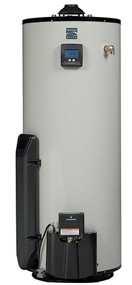
This isn’t coupon related, but it is related to saving money. If you’re a homeowner who’s been considering replacing your home’s water heater, you may want to look into doing that before April 2015.
After April 15, 2015, the federal government is requiring all water heaters sold to comply with a new set of green energy standards and regulations. To achieve these standards, the design of the heaters will be much more expensive than a traditional water heater. Additionally, the new heaters are going to be much larger in design. Especially if your water heater is located inside a closet, you may not be able to fit a newer-styled water heater in the same space.
A friend mentioned this to me today, and it’s something I hadn’t heard about at all. I started looking online for more information. Here are some article excerpts I read this evening:
- “While no one is arguing the benefits of going green, the down side is the upfront cost to the consumer. As a result of new regulations that require a more complicated installation and increased amount of system parts necessary, homeowners could face a hefty replacement fee in the short run.” The added expense, says Thompson, comes in the form of the larger size of the new water heater units. Electric hot water heaters larger than 55 gallons — the minimum required for most residential homes — will require a minimum of 128 cu. ft. with a duct to a larger space in order to comply with the new standards. This means that homeowners will have the added burden of not only replacing a water heater, but potentially also undergoing a major renovation involving construction. (article)
- “In some cases, the water heater may have to be relocated to operate properly or to mitigate noise,” said Sanborn. “While the operating cost of the new water heaters will be less because of their increased energy efficiency, it is likely that the maintenance costs will increase because of a more sophisticated design, and the integration of electronics, blowers, fans, condensers, or other components.” Another drawback is that a new water heater is likely to have lower hot water deliverability than prior models. “For example, a model with less input may be required to achieve the higher efficiency, which will ultimately result in less hot water delivered,” Sanborn said. (article)
- “The cost for one of these will be going up significantly, according to water heater expert Chip Cochran. ‘You will have to buy a heat pump water heater and those water heaters on top of them will have a compressor and an evaporator coil, a whole refrigeration system similar to what your refrigerator has in order to heat the water cheaper. When this happens, it’s going to double or triple the price of a new water heater, electric or gas, if it’s over 55 gallons,’ Cochran said. If your current water heater is stored in a small utility closet or crawl space, you may need to find a new place for a newer model that requires more insulation and equipment. “It’s going to be bigger. It’s going to be taller. It’s going to take up more room. A lot of water heaters are installed in very tight quarters. So, all of these things could be a major impact if you are replacing a water heater after April in 2015,” Cochran explained.” (article)
And, I read an article on a water heater manufacturer’s website which, to me, seemed a little too excited about this change:
- On the positive side, when products become more complex, it is less likely that they will be purchased and installed by the do-it-yourself consumer. Therefore, a potential impact of the 2015 water heater changes will be an increase in the share sold through wholesale distribution, thereby, increasing installer opportunities. (article)
Translation: Replacing a water heater used to be easy, but the new ones will be difficult to install. Now we can make more money installing them for you!
I’ve learned from experience that anytime regulations are increased to make something more energy efficient, it usually costs much more, doesn’t work as well, and has unintended side effects. I’m still feeling the sting of incandescent light bulbs being “banned” in favor of CFLs that don’t last as long, don’t work as well, and emit harmful levels of UV-C radiation. (And, of course, their mercury content prevents you from throwing them away too.) It’s not good if they’re already telling consumers to expect lower performance from these new water heaters!
If your water heater is older or is nearing the end of its life, you may want to look into replacing it sooner than later.
Here are some links to browse water heater prices at area stores:
- Browse water heaters at Sears Outlet
- Browse water heaters at Sears
- Browse water heaters at Home Depot
- Browse water heaters at Menards
- Browse water heaters at Ace Hardware
Thanks to my friend Bill for the heads-up on this story.











llamalluv says
I question Thompson’s assertion that a 55 gallon water heater is “the minimum required for most residential homes”. We currently have a failing 40 gallon water heater, and we just purchased the replacement for it. The 40 gallon did fine for us for the past 5 years, but in the last couple of months it started getting fussy and taking a long time to recover if we run two showers and a load of laundry in the morning (rare!), and our plumber friend recommended we replace it this spring. We opted to go to a 50 gallon size so that we could turn the temp down a few dozen degrees for our children’s safety. Due to improvements in technology since our old one was manufactured, the higher capacity tank is very nearly the same external dimensions as our old one.
moshop says
So let me get this right, the new units will be bigger, so people will buy a smaller unit so it fits where the old one did and use more energy to keep the home in hot water because of the smaller capacity. Now how is this being green?
Turken says
Tankless heaters (and point-of-use heaters) are another option to consider. Generally not popular in the US due to higher initial cost vs. traditional tank heaters, but are actually greener because there is no heat lost to water just sitting there cooling.
Now that new regulations are requiring change, it may be time to go for the tech which is better and should only get cheaper in the long-term (kinda like how LED lights are significantly better than CFL’s but were so expensive for some time after the mandated lighting switch)